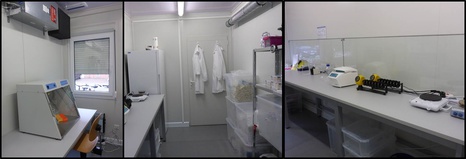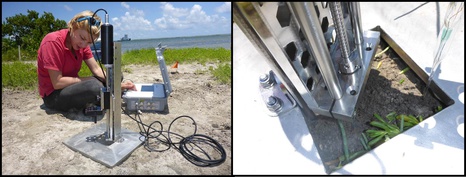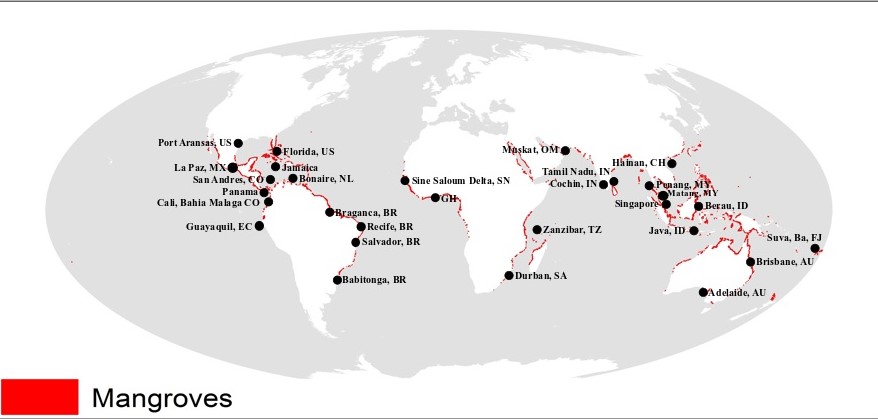Follow news, events and activities about mangrove conservation and restoration on "World of Mangroves"!
About the work group Mangrove Ecology
Mangroves are forests that dwell along tropical and subtropical coasts and provide a link between the sea and land. Both locally and globally, they provide a basis for the production of food, and local communities use them as a source for wood extraction. From an ecological perspective, they support a detritus-based food web through exporting their leaf litter into estuarine and coastal waters, where it supports a plethora of marine life that uses mangroves as shelter, migration site or nursery. The accretion and stabilization of sediments contribute to protecting teh coasts from erosion and storm surges. Being popular touristic sites, they offer aditional income for local people.
Mangroves are among the most efficient CO2-sinks: because of their high productivity, they store more carbon and nitrogen in their biomass and the sediments than many other ecosystems. Hence, they potentially contribute to mitigating climate gas-driven climate change.
Almost worldwide, mangroves are threatened by human use and exploitation - e.g., wood extraction and clear-cutting, pollution and eutrophication of rivers and coastal waters, dredging and diking for land-claiming- as well as by the ongoing (relative) sea level rise. With an annual rate of almost 1%, we loose mangroves worldwide even more rapidly than tropical rain forests, and within the next 100 years, mangrove might be entirely lost.
Besides the direkt loss of biodiversity and ecosystem services, the ongoing loss of mangroves exhibits indirect effects on adjacent ecosystems, such as seagrass meadows or coral reefs, that suffer from increased sedimentation upon removing mangroves. Further, the destruction of mangroves eradicates breeding- and nursery areas of numerous marine species.
Through observational, experimental and modelling approaches, the Mangrove Ecology Group aims at providing a scientifically sound basis for the sustainable use, management and conservation of mangroves worldwide.
Research Approaches and Methods

Lab for extracting envDNA (contact: V. Helfer; S. Peters)
Our aim is to provide a reliable scientific fundament for the protection, rehabilitation and the sustainable use of mangroves that can serve as guideline for stakeholders and decision-makers for the planning and management of protected areas: For this, knowledge and in-depth understanding of the ecosystem is required - Which organisms occur under which environmental conditions (biodiversity)? How do organisms interact (biotic interactions), and how to they respond to environmental change? How will the ecological community change, when the environment and resource-use by humans will change (model-based projections)? Which processes are currently driven by the community, and how will this change in the future (ecosystem processes)? Which ecosystem services result from these processes, how are they utilized by whom (social-ecological systems analysis), and how can their use be rendered sustainable (conservation-prioritization, -planning and -management)?

(pyrolysis-)gas chromatography/mass spectrometry for analyzing organic matter in plants and sediments (contact: M. Zimmer; R. Himmelsbach)
We describe mangrove communities with the aid of classical faunistics and floristics but also through metabarcoding (and metagenomics) of environmental (and microbial) DNA. Correlations between community composition and environmental conditions are translated into models that project future future mangrove communities in space and time. With a focus on sediment processes and dynamics, we analyze the chemical structure (metabolomics: (py-)GC/MS; NIRS) and the dynamics (transcriptomics) of organic matter and quantify fluxes (export/import) of elements and nutrients (micro-sensors). Further, we study the accretion and erosion of sediments as they depend on mangrove community composition.
.

Micro-sensors for small-scale analysis of environmental parameters in sediments (contact: M. Zimmer; L. Gillis)

Greenhouses for raising mangrove treelings (contact: M. Zimmer; A. Meyer)
Field study-sites of the Mangrove Ecology Group
Red colors indicate coastal areas with mangrove vegetation.
Map adapted from:
Giri. C, Ochieng E, Tieszen LL, Zhu Z, Singh A, Loveland T, Masek J, Duke N (2011). Status and distribution of mangrove forests of the world using earth observation satellite data (version 1.3, updated by UNEP-WCMC). Global Ecology and Biogeography 20: 154-159.
http://onlinelibrary.wiley.com/doi/10.1111/j.1466- 8238.2010.00584.x/abstract
http://data.unep-wcmc.org/datasets/4
Recent Publications from the group (last three years)
Ouyang X, Kristensen E, Thornber C, Zimmer M, Yang Z, Lee SY. 2023. Response of macrophyte litter decomposition in global blue carbon ecosystems to climate change. Global Change Biology 00: 1–15. https://doi.org/10.1111/gcb.16693
-
Zimmer M. 2022. Mangrove Forests: Structure, Diversity, Ecosystem Processes and Threats. In: Junk W, Wittman F (eds). Encyclopedia of Inland Waters, Second Edition. Elsevier. 116-127. (doi.org/10.1016/B978-0-12-819166-8.00149-3)
Zimmer M, Ajonina GN, Amir AA, Cragg S, Crooks S, Dahdouh-Guebas F, Duke N, Fratini S, Friess DA, Helfer V, Huxham M, Kathiresan K, Kodikara KAS, Koedam N, Lee SY, Mangora MM, Primavera J, Satyanarayana B, Yong JWH, Wodehouse D. 2022. When nature needs a helping hand: different levels of human intervention for mangrove (re-)establishment. Frontiers in Forests and Global Change 5: 784322 (doi.org/10.3389/ffgc.2022.784322)
Zimmer M, Helfer V. 2022. Mangrove forests - a nature-based solution for climate change mitigation and adaptation. Rural21 56: 23-25.
-Albrecht OT, Glaser M, Zimmer M. 2021. Are crab-collectors in mangroves of Northern Brazil (PA) optimal foragers? Wetlands 41: 91-99 (doi.org/10.1007/s13157-021-01488-5)
Quadros AF, Helfer V, Nordhaus I, Reuter H, Zimmer M. 2021. Functional traits of terrestrial plants in the intertidal: A review on mangrove trees. Biological Bulletin (doi.org/10.1086/716510)
Zimmer M, Kimeli A. 2021. Mangroven als Sedimentfallen und Küstenschützer. Geographische Rundschau 7/8: 26-31.
Rahman MM, Zimmer M, Ahmed I, Donato D, Kanzaki M, Xu M. 2021. Co-benefits of protecting mangroves for biodiversity conservation and carbon storage. Nature Communications 12: 3875 (doi.org/10.1038/s41467-021-24207-4)
Seer F, Putze G, Pennings SC, Zimmer M. 2021. Drivers of litter mass loss and faunal composition of detritus patches change over time. Ecology & Evolution 11: 9642-9651 (doi.org/10.1002/ece3.7787)
Forgeron SJ, Quadros AF, Zimmer M. 2021. Crab-driven processing does not explain leaf litter-deposition in mangrove crab burrows. Ecology & Evolution 11: 8856-8862 (doi.org/10.1002/ece3.7718)
Gutting R, Syrbe R-U, Grunewald K, Mehlig U, Helfer V, Zimmer M. 2021. The benefits of combining global and local data – a showcase for valuation and mapping of mangrove climate regulation and food provisioning services within a protected area in Pará, North Brazil. Land 10: 432 (doi.org/10.3390/land1004043)
Pradisty NA, Amir AA, Zimmer M. 2021. Plant species‑ and stage‑specific differences in microbial decay of mangrove leaf litter: the older the better? Oecologia 195: 843-858 (doi.org/10.1007/s00442-021-04865-3)
Zimmer M. 2021. Der Schutz von Mangroven und Küstenvegetation wirkt dem Klimawandel entgegen. In: Lozán JL, Breckle S-W, Graßl H, Kasang D (Eds). Warnsignal Klima: Boden & Landnutzung: 295-301 (DOI:1 0.25592/warnsignal.klima.boden-landnutzung.49)
-
Le Minor M, Zimmer M, Helfer V, Gillis LG, Huhn K. 2020. Flow and sediment dynamics around structures in mangrove ecosystems - modeling perspective. In: Sidik F, Friess D (Eds). Dynamik sedimentary environments of mangrove coasts. Elsevier, Amsterdam, The Netherlands: 83-120.
Helfer V, Hassenrück C. 2020. Microbial communities in mangrove sediments. In: Sidik F, Friess D (Eds). Dynamik sedimentary environments of mangrove coasts. Elsevier, Amsterdam, The Netherlands: 142-175.
Zimmer M, Helfer V. 2020. Quantity and quality of organic matter in mangrove sediments. In: Sidik F, Friess D (Eds). Dynamik sedimentary environments of mangrove coasts. Elsevier, Amsterdam, The Netherlands: 369-391.
Schaeffer-Novelli Y, Cintrón-Molero G, Abuchahla GMO (eds). 2020. Brazilian mangroves and salt marshes. Springer, Heidelberg.
Schwenke T, Helfer V. 2020. Beyond borders: The status of interdisciplinary mangrove research in the face of global and local threats. Estuarine, Coastal and Shelf Science (in press) (doi.org/10.1016/j.ecss.2020.107119)
Dahdouh-Guebas F, Ajonina GN, Amir AA, Andradi-Brown DA, Aziz I, Balke T, Barbier EB, Cannicci S, Cragg SM, Cunha-Lignon M, Curnick DJ, Duarte CM, Duke NC, Endsor C, Fratini S, Feller IC, Fromard F, Hugé J, Huxham M, Kairo JG, Kajita T, Kathiresan K, Koedam N, Lee SY, Lin H-J, Mackenzie JR, Mangora MM, Marchand C, Meziane T, Minchinton TE, Pettorelli N, Polanía J, Polgar G, Poti M, Primavera J, Quarto A, Rog SM, Satyanarayana B, Schaeffer-Novelli Y, Spalding M, Van der Stocken T, Wodehouse D, Yong JWH, Zimmer M, Friess DA. 2020. Public perceptions of mangrove forests matter for their conservation. Frontiers in Marine Sciences 7: 603651. (doi.org/10.3389/fmars.2020.603651)
Allard SM, Costa MT, Bulseco AN, Helfer V, Wilkins LGE, Hassenrück C,Zengler K, Zimmer M, Erazo N, Mazza Rodrigues JL, Duke N, Melo VMM, Vanwonterghem I, Junca H, Makonde HM, Jiménez DJ, Tavares TCL, Fusi M, Daffonchio D, Duarte CM, Peixoto RS, Rosado AS, Gilbert JA, Bowman J. 2020. Introducing the Mangrove Microbiome Initiative: Identifying microbial research priorities and approaches to better understand, protect, and rehabilitate mangrove ecosystems. mSystems 5(5): e00658-20. (doi.org/10.1128/mSystems.00658-20)
Dahdouh-Guebas F, Hugé J, Abuchahla GMO, Cannicci S, Jayatissa LP, Kairo JG, Arachchilage SK, Koedam N, Mafaziya Nijamdeen TWGF, Mukherjee N, Poti M, Prabakaran N, Ratsimbazafy HA, Satyanarayana B, Thavanayagam M, Velde KV, Wodehouse D. 2020. Reconciling nature, people and policy in the mangrove social-ecological system through the adaptive cycle heuristic. Estuarine, Coastal and Shelf Science (doi.org/10.1016/j.ecss.2020.106942)
Friess DA, Yando ES, Abuchahla GMO, Adams JB, Cannicci S, Canta SWJ, Cavanaugh KC, Connolly RM, Cormier N, Dahdouh-Guebas F, Diele K, Feller IC, Fratini S, Jennerjahn TC, Lee SY, Ogurcak DE, Ouyang X, Rogers K, Rowntree JK, Sharma S, Sloey TM, Wee AKS. 2020. Mangroves give cause for conservation optimism, for now. Current Biology 30, R135-R158. (doi.org/10.1016/j.cub.2019.12.054)
Perdomo Trujillo LV, Mançera Pineda JE, Medina Calderon JH, Zimmer M, Schnetter M-L. 2020. Massive loss of aboveground biomass and its effect on sediment organic carbon concentration: Less mangrove, more carbon? Estuarine, Coastal and Shelf Science: (doi.org/10.1016/j.ecss.2020.106888).
Saavedra-Hortua DA, Friess DA, Zimmer M, Gillis LG. 2020. Sources of particulate organic matter across mangrove forests and adjacent ecosystems in different geomorphic settings. Wetlands: Wetlands 40: 1047-1059. (doi.org/10.1007/s13157-019-01261-9)
Khan WR, Nazre M, Zulkifli SZ, Mohamad Roslan MK, Zimmer M. 2020. Risk assessment of heavy metal concentrations in sediments of Matang Mangrove Forest Reserve (MMFR). Tropical Conservation Science (in press).
-
Curnick DJ, Pettorelli N, Amir AA, Balke T, Barbier EB, Crooks S, Dahdouh-Guebas F, Duncan C, Endsor C, Friess DA, Quarto A, Zimmer M, Lee SY. 2019. The value of small mangrove patches. Science 363 (6424): 239.
Bertrand A, Zimmer M & Consortium of WP2 of PADDLE. 2019. Report on tropical marine ecosystem dynamics in the last decade. PADDLE-Report WP2-D2.1
Gillis LG, Snavely E, Lovelock C, Zimmer M. 2019. Effects of crab burrows on sediment characteristics in a Ceriops australis-dominated mangrove forest. Estuarine Coastal & Shelf Science 218: 334-339.
Quadros AF, Nordhaus I, Reuter H, Zimmer M. 2019. Modelling of mangrove annual leaf litterfall with emphasis on the role of vegetation structure. Estuarine Coastal & Shelf Science 218: 292-299.
Le Minor M, Bartzke G, Zimmer M, Gillis LG, Helfer V, Huhn K. 2019. Numerical modelling of hydraulics and sediment dynamics around mangrove seedlings: Implications for mangrove establishment and reforestation. Estuarine, Coastal and Shelf Science 217: 81-95.
Zimmer M. 2019. Detritus. In: Jorgensen SE, Fath BD (ed). Encyclopedia of Ecology 2nd edition, Volume 3. Elsevier: 292-301.
Further research projects
PopGalá- Population genetics of mangroves across the Galápagos archipelago (Helfer & Moity (external)) [T. Poprick]
sea4soCiety - searching for solutions for Carbon-sequestration in coastal ecosystems (Zimmer, Breckwoldt, Helfer, Lahl, Nozik) [M. Wölfelschneider, T. Fett, M. Fouqueray]
Effects of burrows of the mangrove crab Ucides cordatus on carbon fluxes in mangrove sediments: a case-study in Caribbean Colombia (Zimmer & Wölfelschneider) [N. Katzer]
Effects of burrows of the mangrove mud lobster Thalassina anomala on carbon fluxes in mangrove sediments: a case-study in peninsular Malaysia (Zimmer & Wölfelschneider) [M. Nusser]
KATRINA - Aquaculture and integrated mangrove rehabilitation in Kalimantan, Indonesia (Zimmer & Kunzmann) (GIZ)[K. Schrader]
Effects of mangrove species on sediment characteristics in Northern Brazil (Helfer, Geburzi & Zimmer) [M. Fouqueray]
Effects of mangrove tree species on sediment fauna and microbiota [Helfer, Geburzi & Zimmer]
Microbial communities I: Temporal dynamics of active microbial communities in mangrove sediments (San Andrés Island, Colombia) (ZMT) [Hassenrück (external) & Helfer]
ExManCoast - Exchange of organic matter between mangroves and coastal waters (Zimmer, Jennerjahn & Helfer) (ZMT) [M. Wölfelschneider]
CONNECT - Mangrove connectivity with the hinterland: element fluxes and animal migration (Zimmer) (PADDLE) [G. Abuchahla]
ReMainMan - Spatio-temporal analysis of canopy gaps in mangrove forests worldwide (Zimmer, Helfer, Mackay (external), Weerts (external) & Protázio (external)) (DAAD) [M.K. Agyekum]







